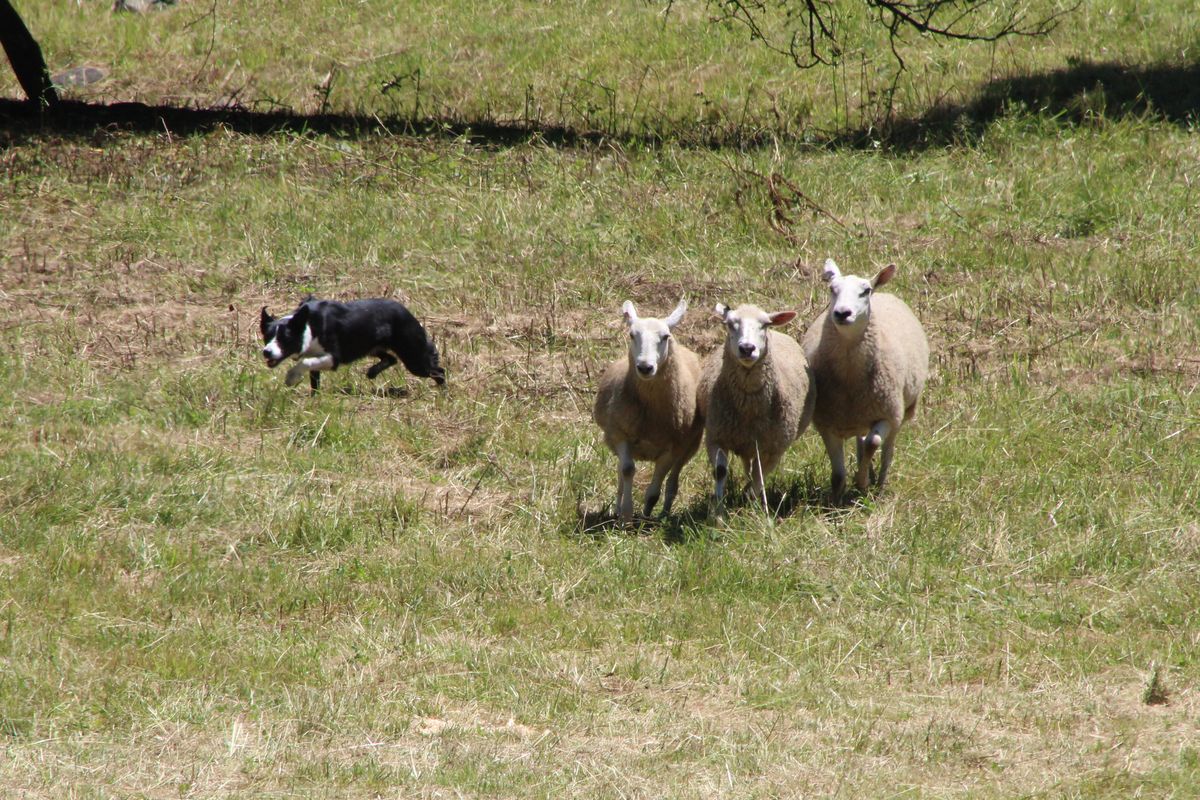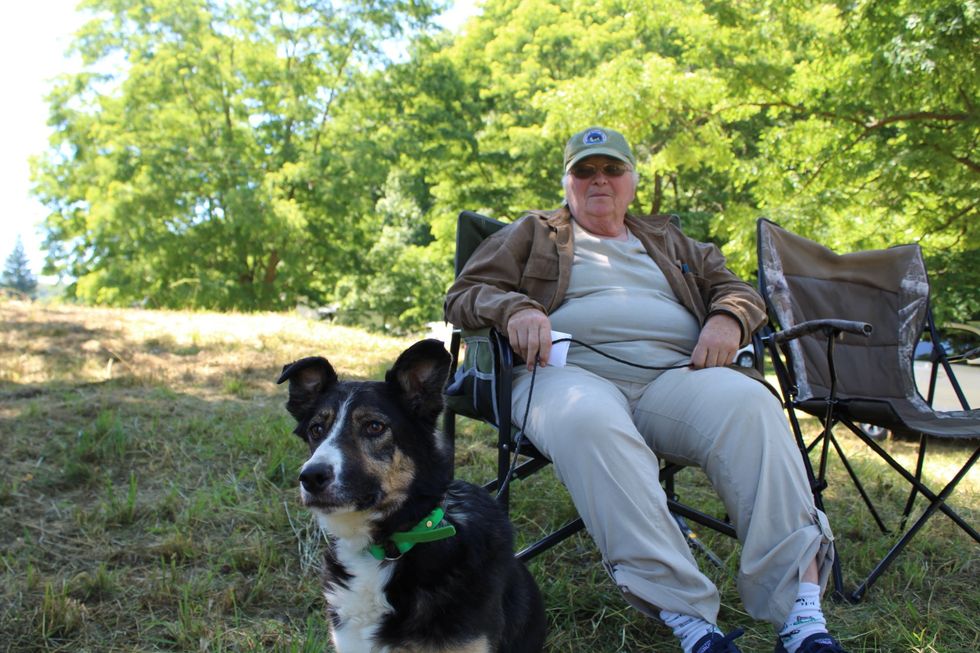Border collies herd sheep with an eye on the prize

Competitive herding trials were held at the Caora Farm in Millerton last weekend, drawing 112 dogs and 68 handlers.
Patrick L. Sullivan

Competitive herding trials were held at the Caora Farm in Millerton last weekend, drawing 112 dogs and 68 handlers.
MILLERTON — Border collies chased sheep about the hillside at Caora Farm in Millerton on Friday, June 28, in competitive herding trials.
The 112 dogs and 68 handlers came from at least eight states and provinces, with Quebec and Ohio the farthest-flung. Judge Neil McVicar is from Scotland.
Caora Farm co-owner Kathleen Weathers greeted a reporter as he pulled in, and provided some quick intelligence.
The event was sponsored by the farm and the Dutchess Land Conservancy (DLC), the contestants were mostly from the North East Border Collie Association and the United States Border Collie Handlers Association, and they’ve been doing it at the farm for about 10 years.
The other owner, Michele Ferraro, steered the reporter to John Campbell of Virginia, who sat in the shade of a tent waiting for his turn with the dog Sadie.
A handler gave a command, and a dog streaked up a long hill where three sheep waited placidly.
The dog then ran around the sheep, causing them to go this way, then that. The dog stayed mostly in the sheep’s peripheral vision, some distance from the animals.
Campbell explained that the competition comes out of “practical farming.” Asked why the dogs don’t get closer and nip at the sheep, he said that biting or anything like it is definitely not on the agenda.
“In the days before antibiotics, a bitten sheep was probably a dead sheep.”
The trials were run over three days because of the sheer number of entries. The Open Trial course is from dogs aged 4-8 and runs for nine and a half minutes.
Ferraro said the course is the same wherever trials are held. The topography is of course different from site to site.

Each dog starts out with 100 points and for every mistake made the dog loses points. Dogs that are in the top 20% of their class receive points for the National Finals, which are held in Virginia in October.
Erin Schultz and Ayla Hill of Sharon watched the trials during their lunch break. The two have their own border collie at home, but have never thought of training their dog to compete. Schultz described the trials as a “fun, unique event for the community” and “ amore old school activity that is becoming more popular.”
Teri Rhodes from Hackettstown, New Jersey, said she has been coming to this event since 2016. She and her husband own a working commercial sheep farm called Wayside Farm. They have about 1200 sheep and 14 border collies: two of which are retired, six actively competing at the Open Level, two in the Nursery class, and four puppies.
Rhodes said she starts training her puppies formally at around 10 to 12 months old but emphasized that “it is all dependent on the dog, and every dog is different.”
Rose Redick from Albany was watching the events Friday with Trixie, a retired border collie.Trixie, who is now nine years old, competed for a few years before having to retire. Asked how long Trixie was able to compete, Redick guessed between two and three years.
She said it would have been longer but “COVID really got in the way.”
Redick was enthusiastic about the Caora Farm trials. “This is a good field with good sheep. It’s a difficult course but it’s fun.”
Campbell and Sadie ended up winning the big prize of the event, the Libby McClintock Award for Most Promising Nursery Pair.
McClintock was the previous owner of the farm and worked with the DLC to preserve the land.
Mad Rose Gallery on Route 44 in the Village of Millerton is decked out with lights and decorations to celebrate the holiday season.
MILLERTON — The Village of Millerton is inviting residents and businesses to enter its annual house decorating contest, with judging now underway through Dec. 28.
Awards will be presented in several categories, including Best Lights, Most Creative, Best Overall and Best Commercial Front.
Entries will be evaluated by a panel of judges using established criteria. Creativity will be judged based on originality, variety of materials used and the use of homemade vs. commercially made decorations. Appearance will consider color coordination, balance and overall attractiveness, while effort will reflect the time and energy put into preparation and presentation.
Judging will be conducted by drive-by observation between 6 p.m. and 11 p.m., and displays must be clearly visible from the street side of the house at night. People and pets may not be included as part of the design.
Winners in each category will receive a gift basket, gift certificates and recognition in The Millerton News. Awards will be distributed on Friday, Jan. 9, 2026.
The contest is open to residents and businesses in the Village of Millerton and the Town of North East. Entry forms can be obtained from Village Hall or at villageofmillerton-ny.gov.
The Upstate Celtic Allstars perform celtic versions of holiday tunes at Amenia Town Hall on Dec. 15, 2024.
AMENIA — Fast becoming a local holiday tradition, the Amenia Town Recreation Department is presenting a free concert by the Upstate Celtic Allstars on Saturday, Dec. 20, at the Amenia Town Hall Auditorium, beginning at 2 p.m.
The five-member Celtic Allstars ensemble will rouse the audience to holiday cheer with a varied program of holiday tunes and rhythmic dance numbers. Appearing in the ensemble are Vermont’s Claudine Langille, vocals and banjo; Dave Paton, hammer dulcimer and concertina, Isa Simon, fiddle and vocals; Joseph Sobol, contemporary cittern (related to guitar); and Ambrose Verdibello, fiddle and guitar.
Refreshments will be served during intermission. Bring the whole family to revel in the lively festivities.